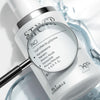
How to recognize quality formulas – PRO HAIR explanation
4 min reading time

4 min reading time
Learn how professionals recognize quality formulas . Discover what an expert reads on the label and which ingredients really make a difference.
How do you recognize quality formulas – what does a professional read on a label?
A good hairdresser does not look at the packaging, but at the formula .
Where customers are guided by scent or marketing, a professional reads the INCI list (International Nomenclature of Cosmetic Ingredients) as if it were a recipe.
The label tells you exactly whether a product really cares – or is just beautifully packaged.
1. The first rule: order determines truth
Ingredients on a label are listed in order of concentration – the first ingredient is the most abundant.
✔ If Water (Aqua) is at the top, that's normal – it's the base.
✔ But if silicones, alcohol or perfume appear too early, the product is more “cosmetic” than caring.
✔ Active ingredients should be in the top 5–10 .
An expert knows: the first half of the list determines the effect, the rest is marketing.
2. What does a professional look for on the label?
Professional products have recognizable restorative or protective ingredients , such as:
✔ Hydrolyzed Keratin / Collagen / Silk – replenishes damaged bonds.
✔ Amino Acids – strengthen structure and elasticity.
✔ Panthenol / Glycerin / Aloe Vera – hydration and suppleness.
✔ Ceramides / Phospholipids – protect the cuticle.
✔ Natural Oils – argan, macadamia, coconut, marula.
✔ pH Regulators (Lactic / Citric Acid) – stabilize and close the cuticle.
A product with these ingredients is active, restorative and long-lasting effective .
3. What does a professional avoid?
An expert immediately recognizes low quality by the composition:
❌ Sodium Lauryl Sulfate (SLS) or Sodium Laureth Sulfate (SLES) – aggressive foaming agents, open the cuticle.
❌ Paraffinum Liquidum (mineral oil) – blocks absorption, works only superficially.
❌ Isopropyl Alcohol – dries out the hair.
❌ Formaldehyde and derivatives – toxic in heat.
❌ Excessive silicone (Dimethicone) – mask effect without recovery.
Professional brands use alternatives such as mild surfactants and biodegradable silicones.
4. The pH value – the invisible key
A formula with perfect ingredients can fail if the pH is not right .
✔ Hair lives between pH 4.5–5.5 – this closes the cuticle and preserves color.
✔ pH above 6 opens the hair → dry, frizzy result.
✔ pH below 4 makes it stiff and fragile.
That is why professionals always check the pH on the label or technical sheet .
5. Labels that do mean something (and those that don't)
Marketing labels such as “natural”, “vegan” or “organic” sound nice, but say little about how they work.
✔ “Vegan” simply means: no animal ingredients – not automatically restorative.
✔ “Natural” says nothing about concentration or pH.
✔ “Sulfate-free,” “paraben-free,” “formaldehyde-free” – these are relevant claims.
A professional relies on formula, not buzzwords.
6. How a professional compares labels
✔ Compare the first 10 ingredients between brands.
✔ Pay attention to order and active ingredients.
✔ Analyze consistency: smells good ≠ works well.
✔ Check compatibility with treatment (Nanoplastia, Hair Botox, etc.).
Professional advice = understanding how ingredients work together rather than what's written on the packaging.
Conclusion: Knowledge of ingredients is the real craftsmanship
Quality isn't found in marketing, but in molecules. A true PRO HAIR expert knows that a product's power lies in its formula —not in promises. Understanding labels can make customers not only more beautiful, but also smarter.